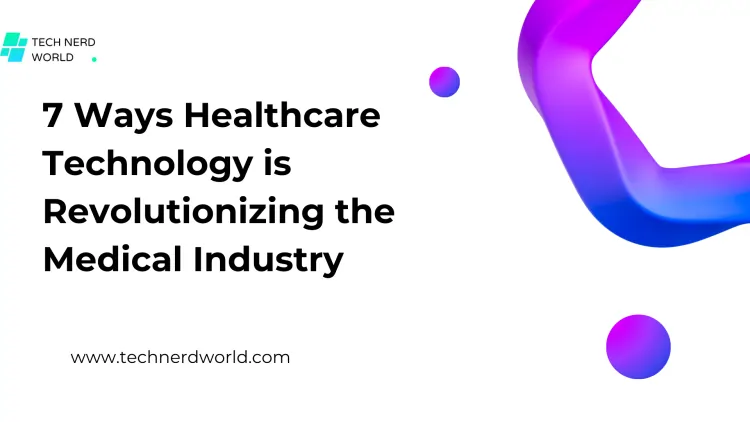7 Ways Healthcare Technology is Revolutionizing the Medical Industry
Discover 7 innovative ways healthcare technology is transforming the medical industry, enhancing patient care, diagnostics, and efficiency.

New healthcare technology has changed patient services and staff care. AI diagnostics, telemedicine, and health apps are examples of tech's benefits. They boost results, increase productivity, and cut costs. This blog post examines seven key ways healthcare tech is changing medicine.
1. AI and Machine Learning: Diagnostics' Future
Healthcare is increasingly relying on machine learning (ML) and artificial intelligence (AI). These technologies can analyze vast amounts of medical data. They do it faster and more accurately than people can. AI in diagnostics can recognize patterns in medical images. It can spot early signs of illnesses, like cancer. It can even predict a patient's risk of certain diseases.
AI-powered solutions are already being applied to:
• Medical imaging for early cancer detection.
Using medical records to forecast patient outcomes.
Wearable technology is being used to monitor long-term conditions like diabetes.
2. Telemedicine: Improving Access to Healthcare
In recent years, telemedicine has expanded rapidly, particularly during the COVID-19 pandemic. Now, patients can talk to medical specialists via phone or video. This enables remote follow-ups, prescriptions, and consultations. This technology has improved healthcare access in rural communities. They had limited medical services before.
Among the main advantages of telemedicine are: • Shorter patient wait times and travel.
• Greater accessibility for marginalized groups.
• Financial savings for healthcare institutions and patients alike.
3. Wearable Technology: Enabling Patients to Manage Their Own Health
Wearable tech, like smartwatches and fitness trackers, is now essential for personal health. These gadgets let users check their health in real time. They continuously check vital signs like blood pressure, heart rate, and blood sugar. Doctors can access this data. It gives them more info about a patient's health outside of routine appointments.
Fitness trackers, a type of wearable tech, check sleep and activity.
• Smartwatches that detect abnormal cardiac beats and deliver ECG data.
• Patients with diabetes who use continuous glucose monitors (CGMs).
4. Blockchain: Protecting Privacy and Security of Data
Patient privacy and data security are of utmost importance in the healthcare industry. Blockchain technology is becoming more popular as a way to address these issues. Blockchain can guarantee that patient data is safe. It provides a decentralized way to store data, making it impenetrable. It also lets authorized parties share data easily, without losing confidentiality.
Blockchain has several uses in healthcare, including: • Safe EHR management.
• Stopping fraud in medical claims and billing.
• Maintaining supply chain transparency for pharmaceuticals.
5. Robotic Surgery: Improving Accuracy and Reducing Hazards
Robotic surgery has changed surgery. It enables very precise, minimally invasive operations. Robotic tech lets surgeons perform delicate surgeries more accurately. It results in smaller incisions, quicker recovery, and less suffering for patients. Cardiovascular operations and orthopedic surgeries are two common applications for robotic-assisted surgery.
• Urological treatments.
Robotic surgery is expected to grow. It should improve care and reduce the risks of traditional surgery.
6. Health Apps: Easily Accessible, Tailored Care
Health management is now simpler and more individualized thanks to mobile health apps. These apps help patients manage their well-being daily. They provide mental health support and track drug schedules. They also inform doctors about a patient's lifestyle. This helps to tailor treatment.
Health apps that remind users to take their meds on time are very popular.
• Apps for mental health that provide relaxing methods and therapy.
• Fitness applications for goal-setting and workout tracking.
7. 3D Printing: Progressing Medical Devices and Prosthetics
In medicine, 3D printing is causing a stir. It's especially true for personalized implants, tissues, and prosthetics. 3D printing lets healthcare practitioners design custom medical gadgets for each patient. Patients get better results and greater comfort as a result of this personalization.
In medicine, 3D printing makes custom prosthetics. They fit each patient's body.
Personalized surgical instruments for more precise operations; bioprinting tissues for regenerative medicine.
Conclusion: Embracing Healthcare Technology's Future
Both patients and healthcare professionals can gain from new healthcare tech. It's creating revolutionary changes. These developments are paving the way for a better healthcare system. It will be more effective, efficient, and patient-centered. It will improve diagnostics, access, data security, and treatment precision. As technology advances, we may see new innovations that will impact medicine.
The promise of better health has never been higher. New technology is being used by patients, providers, and innovators.
This blog is well-organized. It uses headings and subheadings. They cover important aspects of healthcare technology in an interesting, easy-to-read way.
What's Your Reaction?













